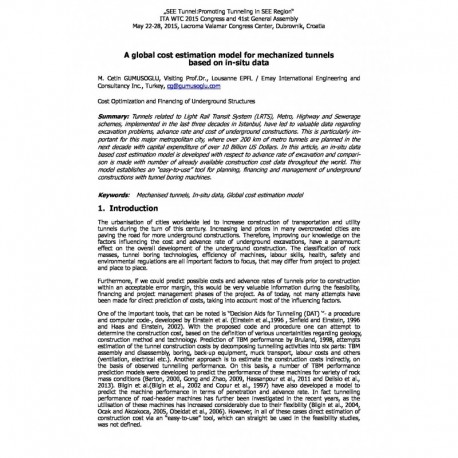Cart
0
0
No document
0,00 €
Total
Document successfully added to your shopping cart
Quantity
Total
There are 0 items in your cart.
There is 1 item in your cart.
Total documents
Total shipping
To be determined
Total
Search & filter
Search for a publication
Search & filter

A global cost estimation model for mechanized tunnels based on in-situ data
wtc2015_full_gumusoglu
The urbanisation of cities worldwide led to increase construction of transportation and utility tunnels during the turn of this century. Increasing land prices in many overcrowded cities are paving the road for more underground constructions. Therefore, improving our knowledge on the factors influencing the cost and advance rate of underground excavations, have a paramount effect on the overall development of the underground construction. The classification of rock masses, tunnel boring technologies, efficiency of machines, labour skills, health, safety and environmental regulations are all important factors to focus, that may differ from project to project and place to place. Furthermore, if we could predict possible costs and advance rates of tunnels prior to construction within an acceptable error margin, this would be very valuable information during the feasibility, financing and project management phases of the project. As of today, not many attempts have been made for direct prediction of costs, taking into account most of the influencing factors. One of the important tools, that can be noted is ‘’Decision Aids for Tunneling (DAT) ‘’- a procedure and computer code-, developed by Einstein et al. (Einstein et al.,1996 , Sinfield and Einstein, 1996 and Haas and Einstein, 2002). With the proposed code and procedure one can attempt to determine the construction cost, based on the definition of various uncertainities regarding geology, construction method and technology. Prediction of TBM performance by Bruland, 1998, attempts estimation of the tunnel construction costs by decomposing tunnelling activities into six parts: TBM assembly and disassembly, boring, back-up equipment, muck transport, labour costs and others (ventilation, electrical etc.). Another approach is to estimate the construction costs indirectly, on the basis of observed tunnelling performance. On this basis, a number of TBM performance prediction models were developed to predict the performance of these machines for variety of rock mass conditions (Barton, 2000, Gong and Zhao, 2009, Hassanpour et al., 2011 and Delisio et al., 2013). Bilgin et al.(Bilgin et al., 2002 and Copur et al., 1997) have also developed a model to predict the machine performance in terms of penetration and advance rate. In fact tunnelling performance of road-header machines has further been investigated in the recent years, as the utilisation of these machines has increased considerably due to their flexibility (Bilgin et al., 2004, Ocak and Akcakoca, 2005, Obeidat et al., 2006). However, in all of these cases direct estimation of construction cost via an “easy-to-use” tool, which can straight be used in the feasibility studies, was not defined.


